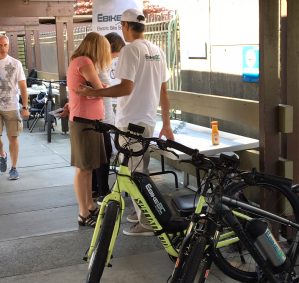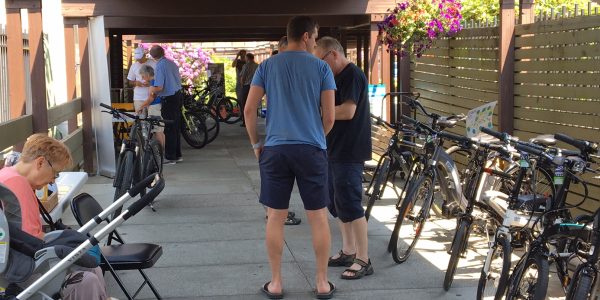E-bike show and tell at Lions Gate Hospital draws staff and visitors
On Monday, July 17, four electric bike vendors set up a display at Lions Gate Hospital to present a show and tell for interested staff and visitors. There were over 10 examples of e-bikes and conversion kits (a regular bike transformed with an electric assist wheel) on display for a brief test ride, and the experts were on hand to answer questions.
Feedback from the exhibitors was that the LGH crowd had already done its homework and had some very sharp questions. If you are considering an electric bike, or a conversion kit, it pays to do your homework.We have compiled excerpts from the exhibitors who were at LGH along with some of the most informative questions (and answers) from the event.
Q & A with OHM Cycles
Q: What about security? How do I keep bike secured to prevent theft?
A: OHM includes an ABUS folding lock with bike purchase. This is compact lock which unfolds to lock to any bike rack. We suggest using 2 x locks if parking bike for extended periods in high theft area.
Q:How far does it go?
A: OHM electric bikes have maximum range of 130km in lowest assist setting. The average range is 50 km using higher assist settings.
Q:What’s different about your e-bikes?
A: Our drive system manufactured in North America and bikes are backed by industry leading 3-Year-Warranty.
Q: Where can I go to test ride?
A: Our showroom in North Vancouver is located at 103 – 930 Harbourside Drive (Close to Thomas Haas). We offer free test rides for up to 2 hours.
Q: Which Electric System is better – mid-drive one or a hub motor based one?
A: Both systems have their pros and cons:
Mid-drive applications run power from a motor through the same drive train as rider’s pedaling. This provides better efficiency, and better support for climbing applications at low speeds, understanding that gears on the bike are selected properly. The downside is that it feels less natural because of that coupling of the motor and rider’s effort at the pedaling level. Furthermore – incorrect shifting, bad gear selection can produce a significant stress on a motor, and the transmission.
Hub motors are independent from the drive train so the pedaling feel is completely natural and the motor is not under any significant stress when shifting gears, even when done incorrectly. Efficiency on the other hand suffers in low speed climbing applications, so much more powerful motor has to be used to achieve the same result as a smaller, mid-drive one.
It is also worth noting that most of the mid-drive applications do not include throttle (power on demand) so the motor works only when rider pedals. Hub motor implementations usually include a throttle in addition to the pedal assist, plus many direct-drive hub motors come with the re-gen features (re-generative braking, and re-generative riding modes).
Q: Which one is better – a purposely built electric bike, or a retrofit one?
A: A purposely built electric bicycle definitely has the advantage of a slick look thanks to its purposely built frame. They usually provide features like frame battery, integrated lights, etc. On the other hand choice of bicycle styles, and even frame sizes is rather limited here. A retrofit electric system can enable virtually any standard bicycle to became electric one, which is a big plus. The drawback here is it doesn’t have the slick, tidy look of a purposely built one, and it lacks some integrated features.
We have to add one important note of caution for many of DIY people out there – an electric bike conversion that is not done properly can jeopardize the bike frame, and some other components making the bike unsafe to ride. Yes, many bikes can be retrofitted, but not exactly every particularly old ones with a questionable frame strength.
Exhibitors
While VCH supports an active and healthy commute for employees, VCH does not endorse these companies or products. Employees should treat these vendors with the same diligence as any commercial transaction.
EbikeBC is a B.C. company offering innovative solutions to convert regular bicycles to top of the line e-assist electric bikes.Versatile light weighted, high performance, low cost, silent, reliable & maintenance free, nice looking and ergonomic conversion kits to be installed on almost any existing regular bicycle in the market with extended warranty and support.
JV Bike is the first store in BC offering proportional power assist bicycles and systems for 14 years now. Back in 2003 we were the first dealer outside of Quebec to offer, now well known, and proudly Canadian product – BionX System. During all these years we were working with so many other electric bicycles and conversion kits, and we gained such a level of experience in this field that is hard to find in any other bicycle store. Today JV Bike offers complete, pre-built electric bicycles, as well as retrofitting standard bicycles to electric ones. Bikes in our selection come with a quite variety of propulsion systems – hub motors and mid-drive motors from brand names like BionX, Shimano Steps, Bosch, Pendix, etc.
OHM Cycles was founded in 2005 in Vancouver. OHM produces high-quality electric bikes with exceptional riding range and features. Our E-Bikes are lightweight and offer a premium riding experience through their powerful drive system, long battery range, superior components, comfort and versatility. OHM is the most reliable electric bike with our drive system manufactured in North America. We offer competitive prices and direct customer contact. All bikes are backed by our industry leading 3 Year Warranty.
Grin Technologies is a small Canadian engineering company based in Vancouver that is dedicated to advancing the state of after-market electric bicycle conversion kits. We take pride in designing and making clever electric bike parts and accessories that are universal in nature and not locked to proprietary standards. Originally incorporated in November 2005 as two companies “The Renaissance Bicycle Company” and “Petro Can’t Ebike Accessories”, we merged operations and changed names in 2010 to Grin in order to better reflect our wide scope of EV activities.

Staff listen to Ali from EbikeBC.com about that company’s electric bikes.

